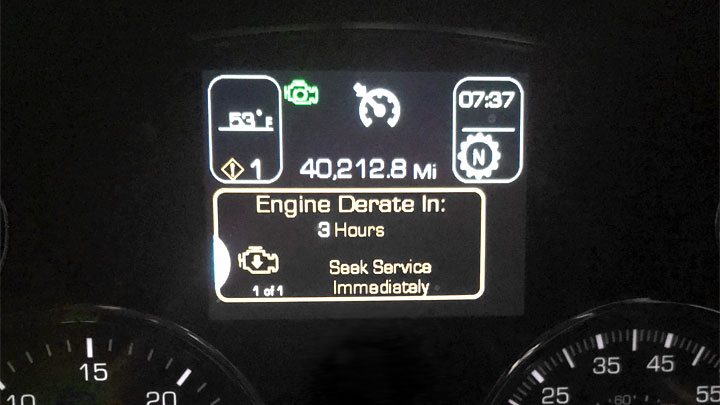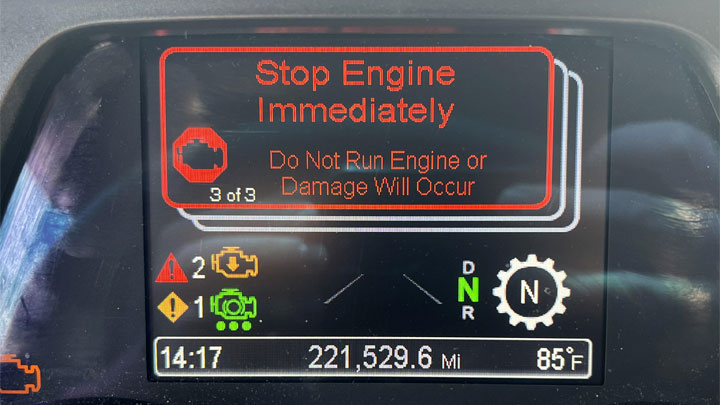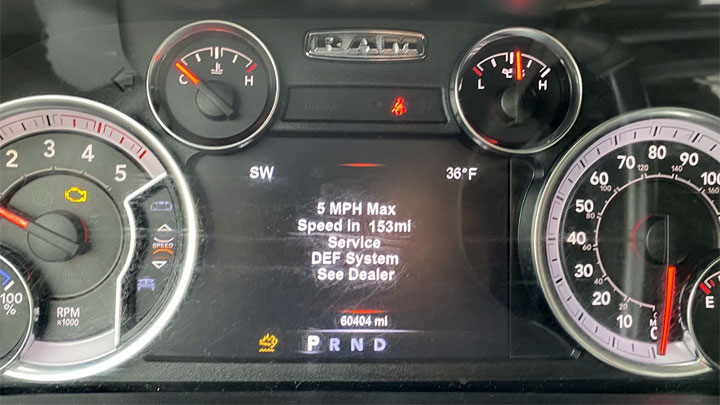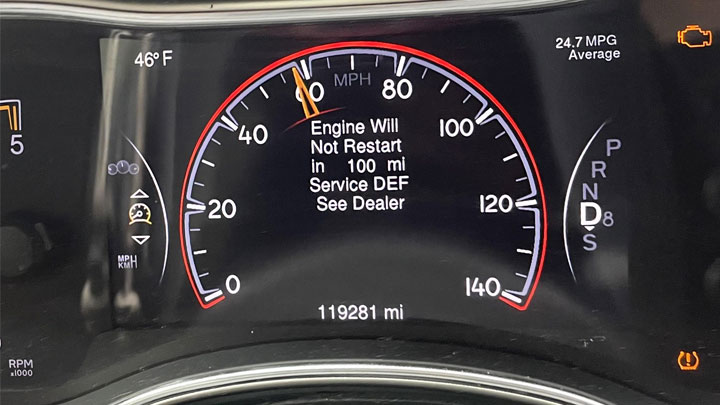What Does Engine Derate Mean? (and What Causes It?)
Though hearty, the diesel engine is not impervious to occasional breakdown. This is especially true of late-model diesel engines, which come equipped with a host of government-mandated emissions equipment which can limit output when an issue is detected.
This load-limiting function is referred to as “derate” and every diesel owner should familiarize themselves with this function. If ignored, derate issues can leave truck drivers stranded.
Here’s what causes engine derate and more importantly, how to clear it.

What is Engine Derate?
As mentioned, engine derate is a self-protective, or load limiting function that comes pre-programmed into the operating software of most modern diesel engines. This function first became prevalent during the earliest years of the new millennium, when more stringent diesel emissions standards were enacted by the federal government.
The principle of engine derate is quite similar to that of “limp-mode” features utilized by many gasoline-powered vehicles. When an engine enters derate, overall performance is significantly limited, as a means of self–protection.
In this stifled state, an engine generally produces just enough power for its operator to exit the roadway, and seek further technical assistance wherever it is safe to do so.

The exact extent to which a truck derates, or reduces power, varies by manufacturer. Certain engines, such as those bearing the Cummins or Paccar name, feature multiple states of derate, the first of which only limits power to a moderate level. This buys a motorist time to seek assistance and allows them to travel to the nearest truck-qualified truck shop.
However, these same engines, often found in Peterbilt and Kenworth trucks, can also enter a far more severe 5 MPH derate, if the issue at hand is not quickly recognized and remedied. This heightened level of derate is also common in Volvo-brand trucks, as well as some consumer-grade pickups.
If earlier steps of derate are ignored, a truck can actually be forced into a derate-induced shutdown, which will most certainly require the affected vehicle to be towed to a shop for repair.
Additionally, a number of manufacturers have been known to disqualify specific segments of a vehicle’s powertrain warranty, if this level of derate has been reached in the past.

Read Also: What Is Death Wobble?
What Causes Engine Derating?
Engine derate can be caused by a number of specific faults, most of which relate to a truck’s emissions system. Some of the most common of these issues include DEF quality and DPF/SCR catalyst efficiency faults. In general, faults of this type impede upon a truck’s ability to successfully complete its automatic regeneration cycle.
“Regeneration” is a term used to describe the conversion of soot and other particulate matter trapped within a truck’s DPF (Diesel Particulate Filter) into ash. This conversion is achieved through the application of heat and specialty chemical compounds. Diesel exhaust fluid is also introduced into a truck’s SCR catalyst to reduce nitrous oxide emissions.

The modern diesel engine features a number of sensors within its exhaust tract to monitor the efficiency of such reactions. The most prevalent of these sensors include back-pressure sensors, pressure differential sensors, and temperature sensors. If any of these specific sensors provide feedback that is out of specification, engine derate is likely to result.
Outside of standard emissions-related faults, derate can also be induced as a matter of self-protection under a range of additional criteria. However, the exact point at which derate is induced in this manner varies significantly from one manufacturer to the next.
Many trucks will derate if engine coolant or oil levels drop below a specified level, or if overheating is detected.
How to Clear an Engine Derate

Unfortunately, the issue of engine derate is not easily addressed by the average operator or at-home mechanic. This is due to the fact that most manufacturers require a derate condition to be addressed and reset with the use of an OEM-specific scan tool (not your common OBD2 scanner).
This, in turn, leaves most motorists without recourse, outside of visiting an authorized vehicle service center that has proprietary software at their disposal.
Additionally, the underlying fault that has led to an engine’s derate condition must also be remedied before full power can be restored. In many cases, a technician can perform a forced-regeneration (exhaust system cleaning), and reset a truck’s derate status. However, if the exact cause of this excess soot-loading is not identified, further derate will occur in short order.
Forced regeneration can also be used in some cases to buy a certain amount of time before more significant derate protocols are initiated. While such features are not always accessible without a scan tool, some trucks feature a forced regeneration switch that allows a driver to manually initiate the regeneration sequence. This must be done while parked, in a safe location, and away from other vehicles.
In any event, the root cause of engine derate should be addressed as soon as possible. This prevents further levels of derate from being registered and circumvents potential engine damage in most cases.
If you do not feel comfortable tackling such repairs yourself, or simply do not have the proper equipment at your disposal, an appointment should be made with a qualified service center as soon as possible.
- P0480 Code (Symptoms, Causes, and How to Fix) - Apr 19, 2024
- Car Temperature Gauge Stopped Working? (Here’s Why) - Apr 15, 2024
- Ignition Coil vs Coil Pack (What’s the Difference?) - Apr 8, 2024

Have the ground wires checked this same thing just happened with my Silverado. Fixed both ground wires to the engine and haven’t had a problem since.
I love chevys but will never get another. If they would just remove all that electrical crap the brand would be reliable again
On May 20, 2021 I bought a 2016 Chevrolet Colorado turbo duramax diesel 2.8 l 4cyl lwn crewcab lwn with 130,000 miles. The first thing I noticed was the truck feeling like it was shifting down and didn’t matter what type of incline. Then check engine light, stabiltrack and traction control. Then went into engine derat. Towed to shop. They put in one fuel injector and rails, got it back and that same night it started doing the same except didn’t go into engine derate Sent straight back to shop. Then when I got it back it was squealing when I picked it up, the windshield was broken, hood scratched I did go straight back to shop when I drove not even a mile down the road and notice the windshield.
I took pictures and so did they. I didn’t leave a very nice message. They never contacted me back until I contacted the Better Business Bureau because they did install the other 3 injectors but it didn’t help. Then it was just the check engine light that came on and off along with stabiltrack and traction control but would go off and on. I was treated horribly by the financial manager for reporting the issue within his office during financing. They never even tried to contact me when I left the message the following day. But never contacted me until my complaint to BBB.When I then received threatening emails from finance Mgr. Didn’t get resolved. Took it then to a different dealership and they replaced the rear nox sensor and U didn’t get out of the parking lot
and immediately the same day the check engine light came back on. I pulled right back
in they checked it said that it needed the front nox sensor replaced. Then same thing and has been sitting in my driveway since April this year. After spending $6000 in repairs and my truck in the shop basically from August through April and still not running and in limp mode. I don’t know what else to do because I overpaid for the truck, I spent that $6000 in repairs. I did try a online quote for cash sale That was right before the light came back on and I was offered a little over $10,000 less than I originally paid for the truck and now that it’s not running I probably couldn’t even get $10,000 cash offer. This truck has been a nightmare.